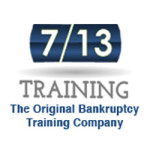This week we wanted to share some recent questions and answers with you, so that all could benefit.
Thanks!
-The 713 Training Team
Join our LinkedIn group:
www.linkedin.com/companies/713training.com-llc
Follow us on Facebook:
www.facebook.com/pages/713Trainingcom/112903945407672
Follow us on Twitter:
www.twitter.com/713Training
QUESTION:
I have a debtor that owns property that he is renting out to his son. The mortgage is $2,000.00 per month and the rent he is charging his son is $2,000.00. I’m not sure how to list it in Schedule I, Schedule J and the Means Test. To me it wipes out any income but I’m sure it must be indicated properly in the schedules and the means test.
Can you help?
ANSWER:
Yes, this will all need to be reported.
The mortgage debt would be reported on Schedule D.
The mortgage payment would be reported on Schedule J (line 1).
The $2,000 monthly income from the son would be reported on Schedule I (line 8).
The $2,000 monthly income from the son would also be reported on the Means Test with other income (If you are using Best Case, I recommend using the “Edit CMI Details” button to enter all sources of income separately, and let the software do the rest of the work for you).
If the debtor has made the monthly payments for the last 90 days, this will also need to be reported on the Statement of Financial Affairs (SOFA) (line 3).
QUESTION:
Good morning, please see the 2nd part of my test for certification previously submitted. I mailed the first part about 3 weeks ago. Please let me know that first and 2nd part have been received.
ANSWER:
Thank you for your email, however, this is the older exam that is now outdated. The updated exam was released last December, and is taken completely online.
To register for the current exam, you can go to www.713training.com/products/VBA-Certification-Exam.html. The exam is now paid for in advance; after doing so, you will be able to download the instructions that you will want to follow very carefully (following detailed instructions is now part of the exam), which will include steps on how to take the exam online.
Your time investment in the older exam will be of a benefit to you, as the updated exam does include things from the original exam.
QUESTION:
I hope you are well. I have attached a 13 for review. I am a little confused about how I listed a couple of property items. My client had a house with her ex-boyfriend that went through a short sale. I listed it on Sch. F (BAC). Also, my client is on the deed to her parent’s house, but only has a life estate interest. I listed it on Sch. B since she is not on the loan. She is also a co-signer on her current boyfriend’s equity line – I put it on Sch. F because she has no rights to the house and is only on the equity line.
ANSWER:
Regarding the debtor’s house that she had with her boyfriend, you’ve listed them on the correct Schedule, being Schedule F, as this house can’t go on Schedule A, since she no longer owns it, making the debt unsecured non-priority.
Regarding the debtor’s parent’s home, since her name is on the deed, I would list this house on Schedule A, and select the “Nature of Debtor’s Interest in Property” as being “Life Estate”.
I would also list the line of credit she co-signed for the boyfriend on Schedule F, as you have done.
I noticed that there is a car payment listed on Schedule J, but no car listed on Schedule B, and no lien listed on Schedule D, perhaps something has been overlooked here.
Also, I recognize some of the numbers on Schedule J, because they match the IRS allowance…the trustee may have the same thought. We have seen petitions get objections for this reason, so you may want to consider going close to these allowances, without actually hitting them, and leaving a little bit of a buffer in there, to avoid a possible objection.
I’m also hoping you can find some additional expenses that have been overlooked by the debtor, to list on Schedule J, to lower the Chapter 13 plan payment from $1,200/mo.
QUESTION:
1) How do VBA’s get paid?
2) What is the amount per petition- imagine this depends on attorney working for?
3) Is there enough work to handle all of us being trained – imagine so but would like to discuss
ANSWER:
Virtual Bankruptcy Assistants (VBAs) get paid by the attorneys they work for. How much they get paid, how often they get paid, and any other details surrounding payment, is determined by the VBA and the attorneys he/she works for.
There is no set amount of pay per petition. You may set your prices at whatever you feel your services are worth, and what attorneys are willing to pay. To give you some guidelines though, we suggest that you not charge anything less than $300 for a Chapter 7, and not less than $400 for a 13, although we are aware of several VBA’s that are being paid much more, because their work is worth much more.
There is so much bankruptcy petition work out there compared to the number of people trained to work virtually drafting petitions, it will be years before we ever know whether saturation is even possible. Because of the volume of work available, more and more attorneys are getting into bankruptcy everyday, and they all need petitions drafted.
Disclaimer: We at 713Training.com not attorneys; any information provided by 713 Training should not be considered legal advice. The information in this article, and any other materials provided by 713 Training, whether delivered verbally, written or via any other means, including electronic/digital delivery and storage, is for training purposes only, and is intended for individuals who work under the direction of a licensed attorney.






